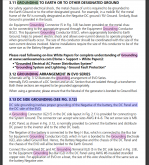Can someone help me translate this into plain english? (this is the advice Victron gives Re: circuit protection for all of their MPPT controllers)
My best attempt at deciphering this is:
You should have a dual pole circuit breaker or switch to disconnect both the positive and negative wires between your PV array and your charge controller, unless your negative wiring is bonded to ground (as it normally is) in which case you should only have a breaker/switch on your positive wire.
I interpret:
Link to manual (text in question is on page 6)
- Provide a means to disconnect all current-carrying conductors of a photovoltaic power source from all other conductors in a building or other structure
- A switch, circuit breaker, or other device, either ac or dc, shall not be installed in a grounded conductor if operation of that switch, circuit breaker, or other device leaves the grounded conductor in an ungrounded state while the system remains energized.
My best attempt at deciphering this is:
You should have a dual pole circuit breaker or switch to disconnect both the positive and negative wires between your PV array and your charge controller, unless your negative wiring is bonded to ground (as it normally is) in which case you should only have a breaker/switch on your positive wire.
I interpret:
- current-carrying conductors: to mean any wire that normally carries current (i.e. positive, and negative, but not ground)
- grounded conductor: 'current carrying conductor' bonded to system ground in a grounded system (in most cases the negative wire).
Link to manual (text in question is on page 6)
Last edited:





